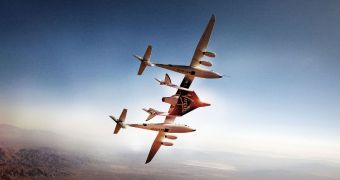The CEO and president of private suborbital spaceflight company Virgin Galactic, George Whitesides, announced on January 20 that the WhiteKnightTwo / SpaceShipTwo combo is nearly ready to enter commercial use. The two aircraft will take paying passengers on suborbital joyrides.
The company has taken an innovative approach to taking passengers to orbit. It uses the WhiteKnightTwo to carry the actual spacecraft high above the surface of the planet. The carrier then releases the SpaceShipTwo from under its belly.
The latter then ignites its own rocket, which takes it to an altitude of about 62 miles (100 kilometers). This is enough for people aboard to experience a few minutes of weightlessness, and to see the curvature of the planet below them.
However, the spacecraft will not reach a stable orbit, and will not perform a single “lap” around Earth. After this stage of the flight is over, SpaceShipTwo will begin its descent, and land on its own at the Mojave Air and Spaceport, in California.
This is where Virgin Galactic and other companies rented facilities in order to conduct their operations. However, none of the operators is currently conducting suborbital flights. Virgin may be the first to conduct powered flights with its spacecraft, maybe as soon as this summer.
“We're now up to over 75 test flights of the WhiteKnightTwo carrier aircraft and 16 glide flights of the suborbital spaceship. We will have more glide flights over the course of the spring,” Whitesides said.
“Over the next few months we're integrating parts and pieces of the hybrid rocket motor into the SpaceShipTwo airframe, completing ground testing of the rocket motor, and then [will] try and start powered flight over the summer,” he added for Space.
Actual commercial flights will not begin until at least 2013. After the first powered SpaceShipTwo is completed, it will have to undergo a number of tests, meant to check the functionality of all its systems.
But the situation looks encouraging at this point. Virgin Galactic was able to conduct a large number of flight tests using this aircraft combo, and all of them were successful. The most advanced technologies on which the company depends have already been proven viable, so this is only a matter of time now.
“We hope to get to space this year and our hope is to be able to start commercial operations from Spaceport America in 2013,” Whitesides concluded. He reminded that a ticket on a SpaceShipTwo run to the edge of space will run paying customers about $200,000 (152,000 euros).

 14 DAY TRIAL //
14 DAY TRIAL //